
Mill town momentum: Residential development heats up on Lewiston’s Riverfront Island
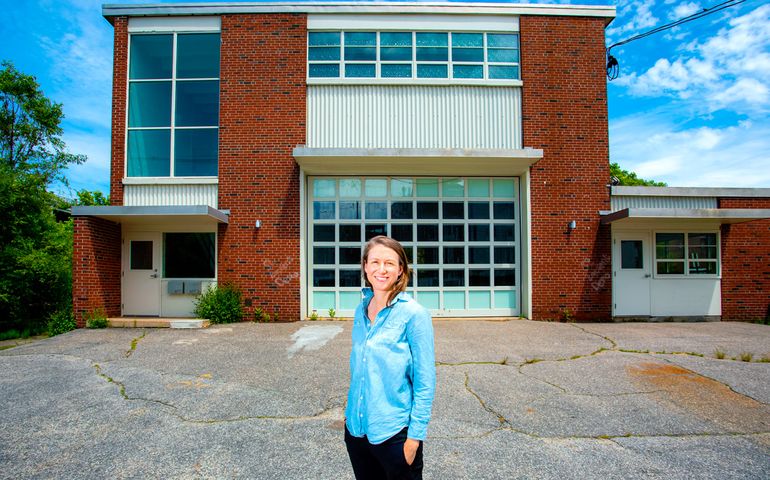 File photo / Tim Greenway
Kara Wilbur
File photo / Tim Greenway
Kara Wilbur
Lewiston is a former mill town with new momentum for residential development. It’s all happening on Riverfront Island, where Kara Wilbur saved an abandoned firehouse from demolition in 2017, then embarked on a $1.2 million revamp financed with $450,000 in historic tax credits, grants and loans from the city, a commercial bank loan and cash out of her own pocket.
The result: A mixed-use building with two modern second-floor apartments that were immediately snapped up, above ground-floor space she hopes to fill as the economy opens up.
The building, now known as 188 Lincoln Street, marks the start of a new development chapter for Maine’s second-largest city, more than two decades after the “Riverfront Island Master Plan” laid out a vision for turning Lewiston’s riverfront into the region’s great urban destination. The 70-acre island is bordered by the Main Canal on the east, the Androscoggin River on the west and north and Cedar Street on the south.
While Wilbur’s endeavor is much smaller than the big transformations that have breathed life into the mill buildings that make Lewiston unique, it’s indicative of growing interest in Riverfront Island as the need for housing grows.
“I definitely took a risk on the fringe of Lewiston though still very much in the walkable downtown area,” says Wilbur, an urban planner and designer-turned-developer who lives in nearby Livermore. “Lewiston is one of Maine’s most beautiful cities and has some of the best historic architecture to work from and a ton of potential that’s completely under the radar … It’s an incredibly untapped market.”
That may not be the case for long as the Riverfront Island renaissance gathers pace, attracting developers rooted in Lewiston as well as newcomers like Wilbur. Down the street from 188 Lincoln Street, Jim Brady of Portland-based Fathom Cos. is embarking on his first Lewiston venture, a residential project in a historic building he bought in December.

Encouraged by Wilbur’s success, Brady says, “She did a nice job with quality finishes and charged a rate nobody in the market thought she could get and got tenants immediately. We’re planning to be a level above her, but to me it showed that people are willing to pay to be in that location.”
‘Sucking the air’ back
Why so much interest in Riverfront Island? Lincoln Jeffers, Lewiston’s director of economic and community development, attributes the appeal to several factors.
“Lewiston has a wonderful historic fabric and most developers I have worked with want to capitalize on and build upon those assets.” He also says a recent $30 million federal grant awarded to Lewiston to make improvements in the 28-block Tree Streets neighborhood raises the city’s overall profile with developers.
In assessing individual projects in the pipeline, Jeffers says the city considers the return on investment, calculating that $60 million in private development money over the past 20 years has brought in an additional $680,000 in annual taxes.

Of the $60 million invested, close to $45 million has gone into mills, complemented by $13.9 million in public money for parks, parking and canal clearing.
But Jeffers notes that the city’s return isn’t just about the tax base, saying, “It can be job creation, services provided or community enhancement.” He adds that progressive city zoning preserves the community’s historic fabric and walkability and allows for a broad range of uses, especially downtown, and estimates that there’s still around 1.2 million square feet of available vacant mill space to fill.
By his count, that includes around 480,000 square feet in the Continental Mill and 140,000 in the Hill Mill, purchased by Newmarket, N.H.-based Chinburg Properties in 2019 and 2020, respectively; and 260,000 in the Bates Mill Complex developed by Tom Platz on the western side of Lewiston’s main canal.
While public and private money has flowed into redevelopment of the eight-building complex over the last two decades, interest in the rest of Riverside Island is of more recent vintage.
That has city officials excited, two decades after the master plan drawn up by Boston-based architectural firm Goody Clancy laid out a vision for an urban, recreation-oriented destination that Jeffers says created a template for how other real estate in the area can be used. He estimates that 35% of the plan has been completed with another 35% underway but still a lot of work ahead.
Pleased with the pace of progress, Jeffers says, “Portland has sucked all the air away for a long time. Now people are discovering that it’s more affordable to live here compared to Portland, and there are some really nice new apartments that are being created in historic buildings.”
The need for more housing is prompted by a booming, diverse economy in Lewiston, where more than 22,000 people work for local firms. Large employers include Central Maine Healthcare and St. Mary’s Regional Medical Center, promotional products distributor Geiger, and Walmart, which has a large distribution center in Lewiston and a retail presence in Auburn.
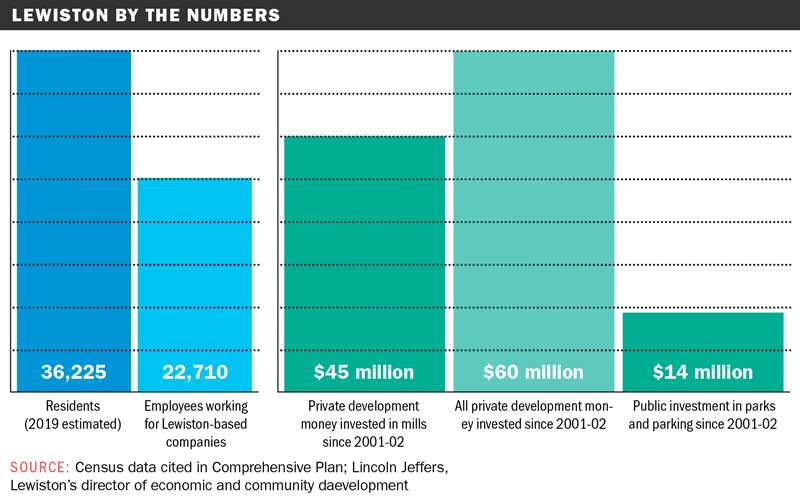
Grand Rounds, a San Francisco-based digital health startup that established a presence in Lewiston in 2016, is also up to 250 employees and 46,900 square feet at the Bates Mill Complex, with plans for further expansion.
“In coming to Lewiston, I wanted to make sure we were entering an area that had the talent to support the kinds of jobs we were going to be hiring for,” says Danielle Snow, the company’s interim COO and chief of staff who runs the Lewiston operations in the town she grew up in. “Once you have the talent, you need to make sure they have an affordable and quality place to live… It’s nice to see investments happening that will enable that.”
‘Robust market’
Inside the Bates Mill Complex, Tom Platz says that while most of the 260,000 square feet of empty space would be suited to residential development, it is quickly filling in with office and commercial users. He also says he’s not lost any tenants because of the pandemic.
As Platz actively seeks tenants for Mill No. 5, he’s branching out into residential development at 35 Beech St., with plans for market-rate housing in a 50,000-square foot mill building he recently acquired.
“I see residential development continuing to grow in the L/A area,” he says. “Rising prices south of us are creating a robust market.”
Another developer adding to the robustness is the Portland-based Szanton Co., which entered the Lewiston market in 2012 with the Loft at Bates Mill, featuring 48 apartments in Bates Mill No. 2. Completed in 2012, it was the first apartment building built in Lewiston’s historic mill district.
More recently in 2019, Szanton built the Hartley Block, a 63-unit apartment building on an empty lot on Lisbon Street and named for local artist Marsden Hartley, whose studio had stood on the site.
While that was a new construction, its next project — currently under contract, with newly approved tax increment financing — is a $22 million plan to transform the Picker House in the Chinburg-owned Continental Mill into a 72-unit apartment building with one-, two- and three-bedroom rental units.
Like Szanton’s other residential properties, it will have a mix of market-rate and affordable housing, according to founder and president Nathan Szanton.
“Jobs are growing faster than the number of housing units are going, inexorably pushing up prices for housing,” he says. “So more supply is really needed in order to stabilize prices.”
If all goes according to plan and the company gets the green light for the Picker House Lofts project by October, it would be looking to close on the deal by June 2022 and start construction soon thereafter to be ready to open by summer 2023.
Szanton has not worked with Eric Chinburg, but he says he’s admired the New Hampshire developer’s work, including Saco Mill No. 4, which was at one time an eyesore that Chinburg “turned into beautiful market-rate housing.”
Szanton shares the same passion for transforming old mill buildings he likens to blank canvases with huge open spaces, and that are structurally sound.
“We’ve done a number of mill adaptive uses, and I just love those buildings — they’re noble buildings,” Szanton says. “They were built to last, and as if the entrepreneurs who built those mills expected them to be going for 200 or 300 years producing textiles.”
That’s reflected in thick, heavy walls, massive timber constructions and huge windows built to let in natural light in before there was electricity, and which Szanton says is well-suited to residential living.
“You have to put good window treatments on, otherwise in the summer you’d wake up at 4:30 in the morning,” he says. “But as long as you do that, they make a beautiful space.”
Irreplaceable buildings
For Fathom’s Brady, the opportunity to invest in Lewiston popped up late last year, when the previous owner of the Dominican Block building — a Queen Anne-style religious building built in 1882 and listed on the National Register of Historic Places in 1980 — decided to sell. Brady acted fast, on a call for offers in early December that closed two weeks later with no contingencies.
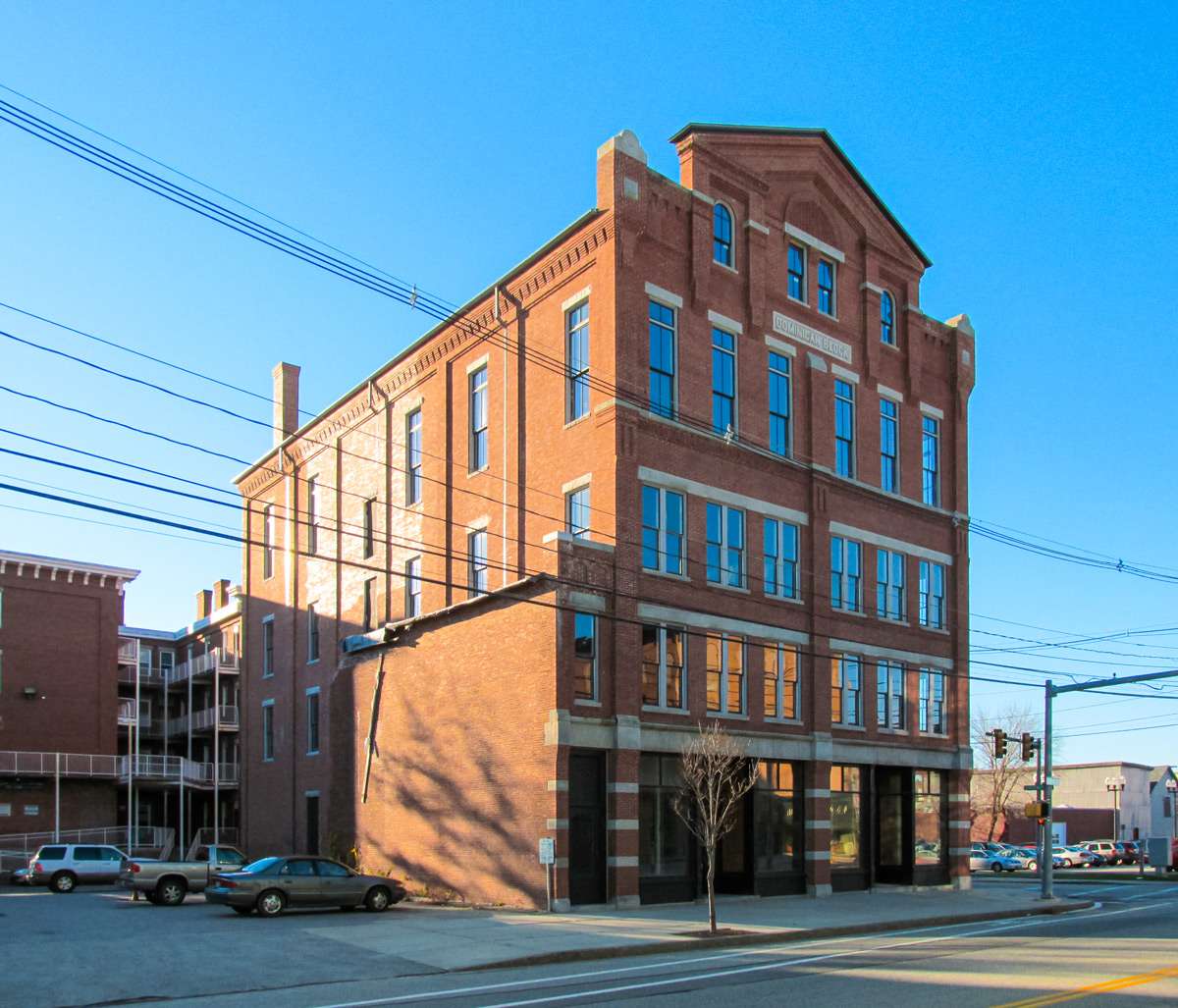
Looking forward to the next steps, Brady says the project exceeds $4.5 million, or about a tenth of what he’s paying to build Portland’s Canopy By Hilton hotel. He envisions around 15 apartments in the revamped Dominican Block, though that’s still being finalized with the architect, Caleb Johnson Studio, as the project goes through permitting. (The builder will be Hebert Construction LLC.)
Amid skyrocketing prices for new construction, Brady is open to doing more redevelopment projects in Lewiston funded by historic tax credits, saying, “We like doing projects in buildings that can’t be replaced.”





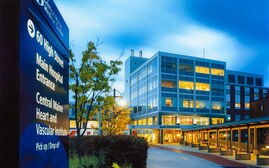
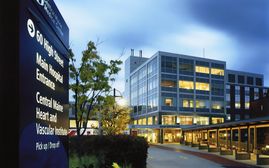





0 Comments